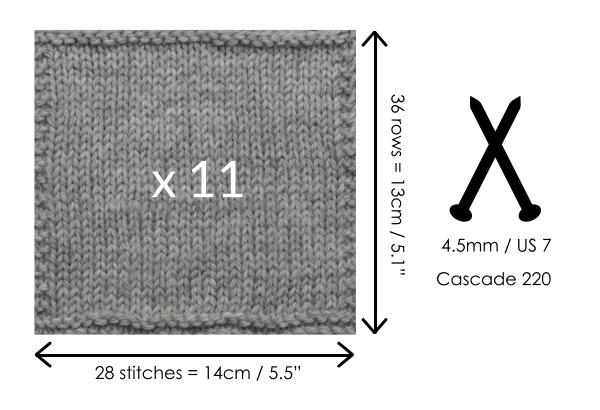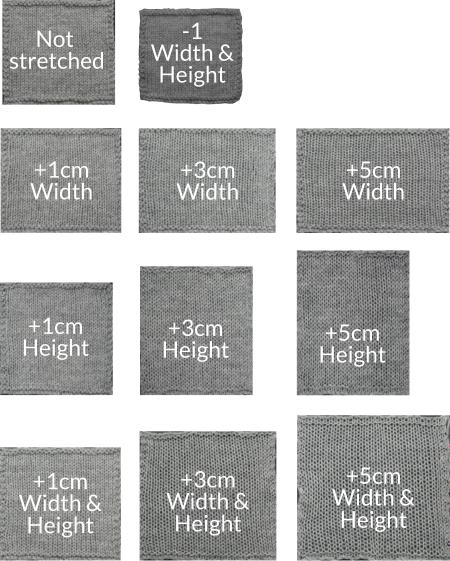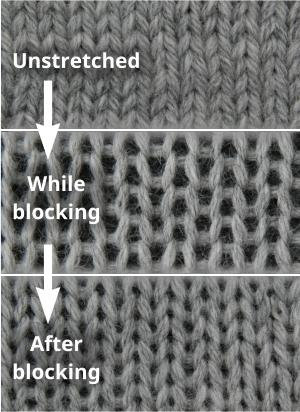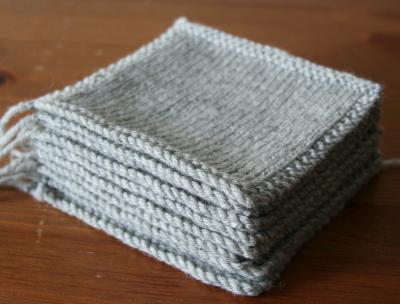I was with a friend recently as she finished a new sweater and tried it on. It was tight width-wise and barely reached her waist.
"Maybe I can block it to size?" she suggested. I wasn't sure, but it struck me as an interesting idea for an experiment. Can stretch-blocking save an ill-fitting knitted garment? And, if so, how far can you go? Time to dust off my lab coat.
The Experiment
Investigate how much extra width and/or length can be added to a garment, by stretching it while blocking, without ruining the look of it.
1. Knit a stack of identical swatches.

The way a yarn responds to being stretched will depend a lot on the fiber it's made from. I chose a 100% wool yarn as that's what my friend used.
I made 11 squares using Cascade 220 on 4.5mm (US 7) needles, each of them 28 stitches wide and 36 rows in length. This gave me squares that were 14cm (5.5") wide and 13cm (5.1") long.
2. Hand wash and pin them out to different sizes.
I stretched the swatches to give extra height, extra width and also in both directions at the same time. They were stretched to give an extra 1cm (0.4"), 3cm (1.2") or 5cm (2").
For completeness, I also tried reducing one swatch in size and I kept one swatch unchanged as a control.

3. Once dry, unpin and measure the swatches.
4. Hand wash, block them again without stretching, and re-measure.
To find out if the change was permanent, I re-washed the swatches and then blocked them to their natural size, i.e. patted them flat and then pinned them without stretching.
Results
| Original size | While blocking | After unpinning | After 2nd wash | |
|---|---|---|---|---|
| Unstretched | Width 14cm Height 13cm |
14 13 |
14 13 |
14 13 |
| –1cm Width & Height | 14 13 |
13 12 |
13 12 |
13.5 13 |
| +1cm Width | 14 13 |
15 13 |
14.5 13 |
14 13 |
| +1cm Height | 14 13 |
14 14 |
14 13.5 |
14 13 |
| +1cm Width & Height | 14 13 |
15 14 |
14.5 13.5 |
14 13 |
| +3cm Width | 14 13 |
17 13 |
15.5 12.75 |
14 13 |
| +3cm Height | 14 13 |
14 16 |
13.5 15 |
14 13 |
| +3cm Width & Height | 14 13 |
17 16 |
15 14.5 |
14 13.5 |
| +5cm Width | 14 13 |
19 13 |
17 12 |
14.5 12.5 |
| +5cm Height | 14 13 |
14 18 |
13.5 16 |
14 13 |
| +5cm Width & Height | 14 13 |
19 18 |
16.5 15.5 |
14 14 |
Discussion
When stretched up to about 5% larger than their natural size, the swatches looked great. Beyond that, the stitches start to look distorted and the largest swatches looked as if they had been knitted on needles four or five sizes too big!
Stretching a swatch an extra 3 or 5cm placed significant stress on the fabric. My blocking pins were under a fair amount of pressure, though I only managed to bend a couple! Stretching a 14cm-wide swatch out to 19cm is an increase of over 35% and it would be impractical to apply that amount of stretch to a whole garment, even if you were prepared to accept the more open look of the fabric after blocking.
About half the length gained during blocking was lost once the pins were removed. This effect was seen across all the swatches, even those that had only been stretched by 1cm. So—for a sweater made of wool at least—in order to gain 5% in width, I'd need to pin it out with a 10% increase. That would mean blocking a 50cm/20" wide sweater to 55cm/22" to achieve a final width of 52.5cm/21".

Stretching in one direction caused a slight reduction in length in the other direction, i.e. pulling widthways led to a reduction in height and vice versa.
The swatches returned (almost) to their original size when re-washed. With the force needed to stretch the largest of the swatches, I had expected some at least to be permanently affected. I was wrong! Once back in the water, the characteristic resilience/memory of the wool fibers reasserted itself, and the swatches returned to their original size. There was a slight gain in size in the swatches that had been the most stretched, but—as per the picture below—they were about as similar in size as you can ever expect a pile of hand-knitted squares to be.

It's possible to block knitting about 5% smaller in size. It was fiddly to reduce the size of the swatch, but it was successful. The reduction remained after the blocking pins were removed.
These results would probably not have been the same if the swatches had been made of another fiber, or I had used another blocking method. I'd like to test some other fibers and blocking methods next year.
Conclusions
It's possible to add about 5% to the width and/or height of a woollen garment without using undue force or greatly distorting the fabric. If you were desperate you could probably push it to 10%. Beyond that, the physical difficulty of stretching and pinning a large piece of knitting, along with the distorted fabric that results, means that it's not feasible.
So, could my friend fix her ill-fitting sweater by stretch-blocking? It was about 50cm/20" long, so, by my calculations, she could add about 5cm/2", at a push. That would make it much more wearable for her. However, the fabric might end up looking more like a stretched elbow patch rather than a new sweater and she'd have to remember to re-stretch every time she washed it.
It's not ideal. My personal conclusion is that I'll keep on making swatches and trying to match the pattern designer's gauge, so I can make the right size in the first place!
